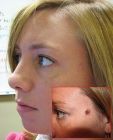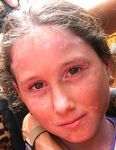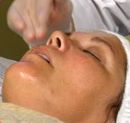What Causes Dark Patches?

Dark Patches
The good news is you no longer have to live with marks on your face. Most skin problems can now be tackled with the right combination of clinical and cosmetic help with a dose of good habits. Pigmentations can be broadly classified into two types: Hyper- and Hypo- pigmentation. Hyper-pigmentation shows up as dark patches – this happens when melanin production is more in some pockets of the skin. When melanin activity is supressed in areas, it creates lighter patches or hypo-pigmentation. This maybe triggered by a medical condition requiring medication; of course, make-up camouflages.

What Causes Dark Patches?
Hormonal Changes, especially during pregnancy; malfunctioning of the , liver and deficiency of vitamins A and B12.
Unprotected Exposure to UV rays. Wheatish complexions are especially prone to this. Freckles and blemishes too are caused due to excessive sun.
Chronic Friction too may lead to patchy skin: If you wear spectacles or have the habit of touching your face a lot, you create regular friction that may lead to patches.
Contact Allergy: that’s caused by reaction to perfumes (especially musk), hair dyes, hair removal creams and other harsh cosmetics.
Acne, pimples chicken pox, eczema and deep skin injury may also leave dark unsightly scars.
How To Get Rid Of Them?
Consult a dermatologist to rule out medical problems. Identify the cause and then choose your course of action. Depending on the nature of pigmentation, you may opt for clinical, salon or cosmetic treatments.

Salon Treatments:
There are two basic methods that help remove dead surface cells, smoothen scars and allow new cells to emerge. Regenerative treatment involves exfoliation of the outer layer of the skin. This can be done by applying a Alpha Hydroxy Acid solution such as glycolic acid. A neutraliser is applied after the solution is wiped off. In the microdermabrasion treatment, ammonia oxide crystals are directed on the skin to remove dead cells. Regenerative treatments are mostly combined with a skin lightening process involving melanin suppressants such as arbutin, licorice and mulberry extracts. These lightening agents are usually in the form of serums or skin lightening packs that are applied after the peel. These treatments take about 30-45 minutes. 8-10 sittings are required at an interval of about 15 days.
Caution
When undergoing these treatments avoid direct exposure to excessive sunlight and make sure you apply a sunscreen lotion with an SPF of at least 15. Apply sunscreen half an hour before going out and re-apply every three hours.

Cosmetic Treatments:
Most brands have a range of products that includes exfoliaters, toners, lighteners, moisturisers and nourishers.
Laser Treatments:
The greatest advancements have come in lasers, including: the IPL to treat large areas of hyper-pigmentation, CO2 lasers for smaller areas and Fraxel’s Restore laser which was recently introduced as a laser that can provide optimal treatment for hyper-pigmentation. In fact, each laser serves a different type of imperfection so it is important to screen several doctors in order to determine if the physician has the particular laser for your need as well as the level of experience that the physician or plastic surgeon has with a specific laser.